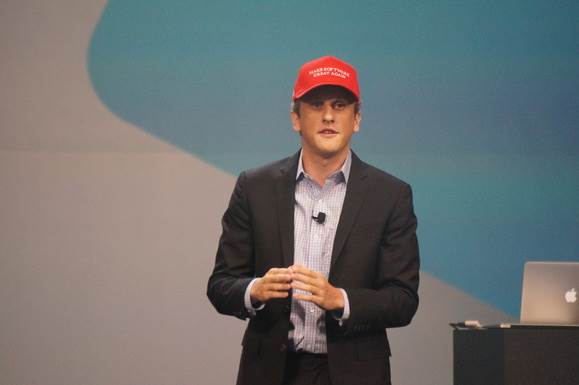Cloud computing trends means that interoperability is king, Box execs say

Box co-founder and CEO Aaron Levie speaks at the company’s BoxWorks conference in San Francisco on Sept. 7, 2016.
Credit:
Blair Hanley Frank
It sounds like the start of a bad joke: executives from Microsoft, Google, Amazon and IBM walk into a conference with one thing in common. But all of those companies are appearing on stage at BoxWorks in San Francisco, in part because they all work with the cloud storage and content services company in one capacity or another.
Box works with Microsoft to integrate its products with Office 365, Amazon to host services in different cloud data centers, and IBM on new applications, services and sales. Google is the newest addition to that club — the two companies announced Wednesday that they’re working on storing Google Docs, Sheets and Slides files inside Box.
With companies increasingly turning to cloud services to power their businesses, both in terms of end-user productivity and application development, it’s becoming increasingly important for tech firms that compete fiercely with one another to also team up, even in areas where they compete.
Box Chief Strategy Officer Jeetu Patel said in an interview that the move towards vendor interoperability is the result of a tectonic shift driven by the rise of cloud computing.
“The reality is, you will never buy, in the cloud, everything from a single vendor,” he said. “And if you do, that’s actually a misguided strategy, because you don’t need to have least common denominators, because you can assume that there’s interoperability between these platforms.”
It’s a shift in the industry that Box is wholeheartedly focused on. The company recently became the first cloud storage provider to announce support for storing Google Docs files outside of Google’s cloud services, just minutes after CEO Aaron Levie extolled his company’s partnership with Microsoft. In an interview, he didn’t see the two partnerships as mutually exclusive, or hurt by one another.
“Just as Microsoft is going to partner with Dropbox and Box when they open up Office, we want to be able to give our customers the same kind of choice,” he said. “And it’s not a sort of thumb on the nose to Microsoft in any sense, because our job is to be a strong platform, and you can’t be a platform if you don’t integrate with the apps that your customers are using.”
All of this is a stark contrast from just a few years ago, when the likes of Microsoft and Google fiercely guarded their vertical stacks. Levie said that partnering broadly is the new normal in enterprise software, as more companies try to serve their customers by working together.
“I don’t think in the future, you’re going to be able to differentiate your products because of either partnerships or because of lock-in,” he said. “You’re going to differentiate your products because of amazing customer experiences, quality of products, usability and the functionality of the product.”
The same story is starting to play out on the application development side as well. Different companies are partnering with one another to try and make it easier for developers to cobble together a group of services to build an app.
It’s still early days for all of these partnerships, many of which were announced in the past year and have only just begun to bear fruit. It’ll likely be a matter of years to see how each deal shakes out with the way customers choose to buy services, along with which players stick around in the market.
But at least for right now, we’re in a brave new world where Microsoft and Google will both partner with a company that directly competes with their products. Go figure.







